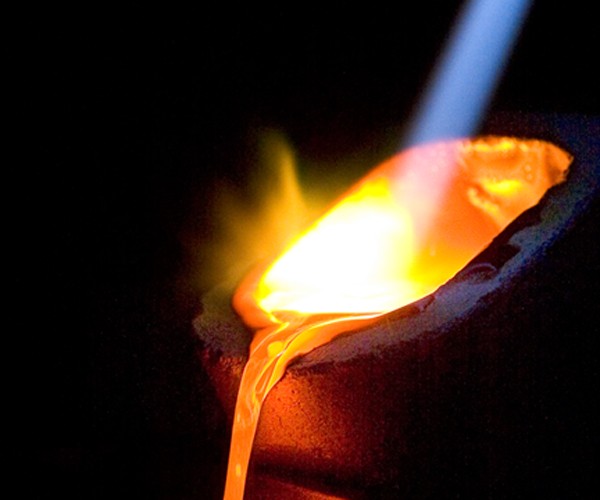The ultimate guide to rhodium metal: a look at its properties and uses
Welcome to our ultimate guide to rhodium metal! In this article, we'll take a closer look at the properties and uses of this fascinating precious metal.
Rhodium belongs to the platinum group of metals and is one of the rarest and most valuable elements of all. Its remarkable properties make it a sought-after material in various industries, particularly in the jewelry industry and automotive manufacturing.
With its exceptional hardness, resistance to corrosion and reflectivity, rhodium is a popular choice for plating jewelry to give it a shiny and long-lasting luster. It is also used in the automotive industry to reduce exhaust emissions and improve catalytic converters.
In this guide, we will talk in detail about the physical and chemical properties of rhodium, explore its uses in various industries and also discuss the sustainable extraction of this valuable metal. Get ready to dive into the fascinating world of rhodium!
Introduction to the rhodium metal
Rhodium is a chemical element with the symbol Rh and atomic number 45 in the periodic table. It belongs to the platinum group of metals, which also includes platinum, palladium, iridium, ruthenium and osmium. Rhodium is a silvery-white metal with a high density and a high melting point. It is extremely hard, corrosion-resistant and has exceptional reflectivity.
Rhodium was first discovered in 1803 by the British chemist William Hyde Wollaston. It was named after the Greek word "rhodon", which means "rose", due to the pink-colored compounds it can form. Rhodium occurs naturally in small quantities and is mainly obtained as a by-product in the extraction of platinum and nickel.
The chemical properties of rhodium
Rhodium is a transition metal and has similar chemical properties to other metals in the platinum group. It does not react with acids or bases and is extremely resistant to corrosion. This chemical stability makes rhodium an ideal material for use in various industries. A remarkable feature of rhodium is its ability to form nitrogen compounds. This makes it an important component of catalysts used in chemical reactions. Rhodium catalysts are used in the production of pharmaceuticals, plastics and many other chemical products.
The physical properties of rhodium
Rhodium is a dense metal with a density of around 12 g/cm³. It has a high melting point of around 1966 degrees Celsius and a high boiling point of around 3727 degrees Celsius. These high melting and boiling points make rhodium a stable and durable material. One of the most remarkable physical properties of rhodium is its extraordinary reflectivity. It is the most reflective element in the periodic table, reflecting around 80% of incident light. This property makes it an ideal material for coating mirrors, optical devices and electronic components.
Possible uses of rhodium in industry
Rhodium is used in various industries due to its unique properties. Here are some of the main uses of rhodium:
Rhodium in the jewelry industry
In the jewelry industry, rhodium is often used to coat jewelry, especially white gold and silver jewelry. Rhodium plating gives the jewelry a bright, shiny and long-lasting luster. It also protects the underlying metal from corrosion and scratches.
A beautiful example of jewelry protected with Tarnish-protected with rhodium Silver Pendant. The rhodium-plated back is visible here.
Rhodium as a catalyst in chemical reactions
Rhodium catalysts are used in many chemical reactions, including the production of pharmaceuticals, plastics and petrochemicals. Rhodium can accelerate chemical reactions and minimize the formation of unwanted by-products. This makes it an extremely valuable material for the chemical industry.
Rhodium as a coating for electronic devices
Due to its exceptional reflectivity, rhodium is also used as a coating for electronic devices such as mirrors, optical lenses and semiconductor components. The rhodium coating improves the performance and durability of these devices and ensures better light reflection.
Rhodium as an investment
Due to its rarity and high demand, rhodium is also seen as an investment. The price of rhodium can fluctuate greatly, but it has risen sharply in recent years. Many investors see rhodium as a stable and profitable investment opportunity.
The extraction of rhodium is a complex and energy-intensive task. As rhodium occurs naturally in small quantities, efficient extraction and processing is required. To ensure the sustainability of rhodium extraction, environmentally friendly methods and technologies are crucial.
One approach to sustainable rhodium mining is to improve recycling processes and reduce the use of environmentally harmful chemicals. In addition, the rhodium industry should strive to minimize energy consumption and use renewable energy sources.
Rhodium is a fascinating metal with extraordinary properties and diverse applications. It is one of the rarest and most valuable elements on earth and plays an important role in the jewelry industry, automotive manufacturing and many other industries. With its hardness, corrosion resistance and reflectivity, rhodium has a unique position among metals. It is used for coating jewelry, as a catalyst in chemical reactions, as a coating for electronic devices and even as an investment.
Sustainable extraction of rhodium is crucial to minimize the environmental impact and ensure that this valuable raw material is available for future generations.
Overall, rhodium is a remarkable metal that fascinates us with its versatility and beauty. It will continue to play an important role in the industry and impress us with its unique properties.






